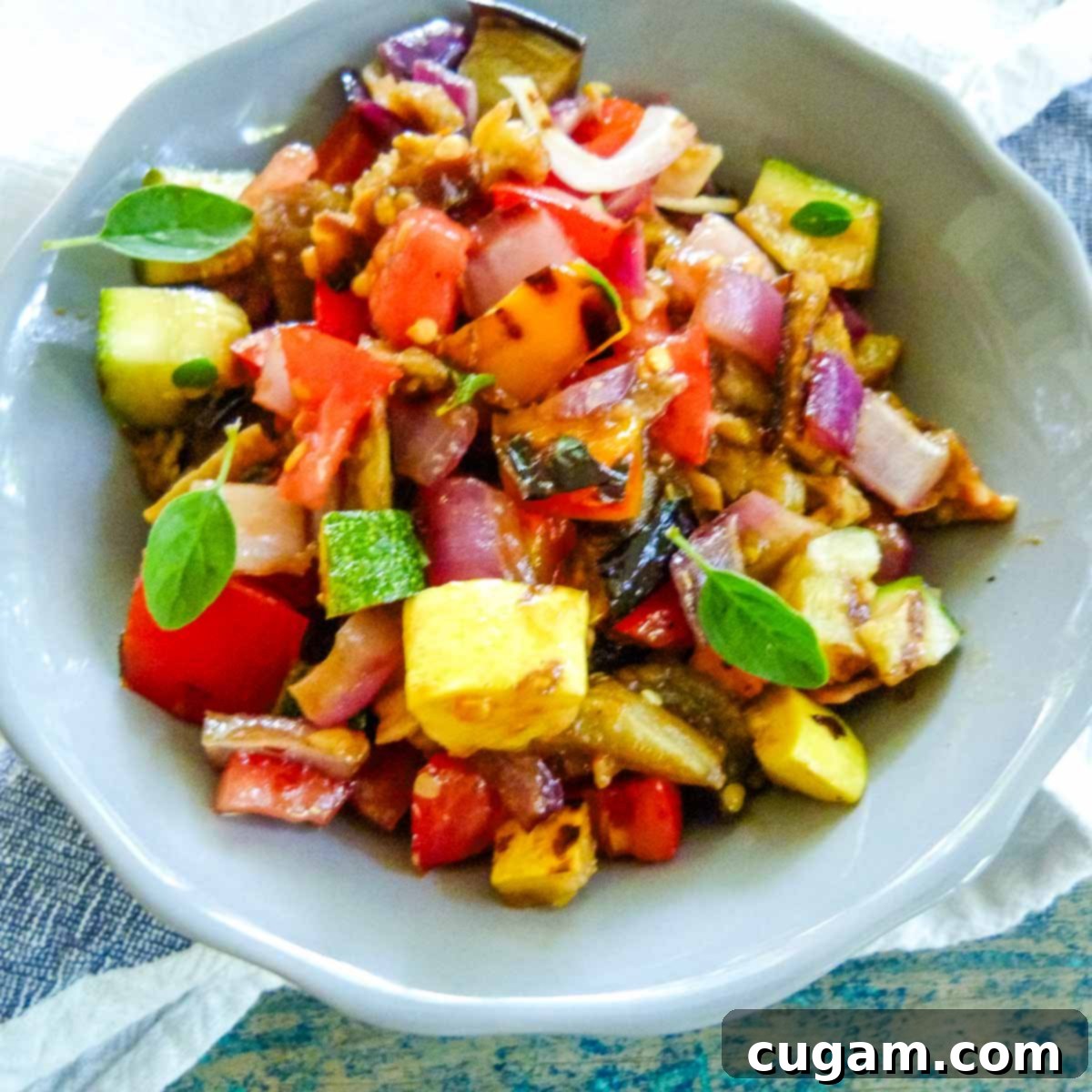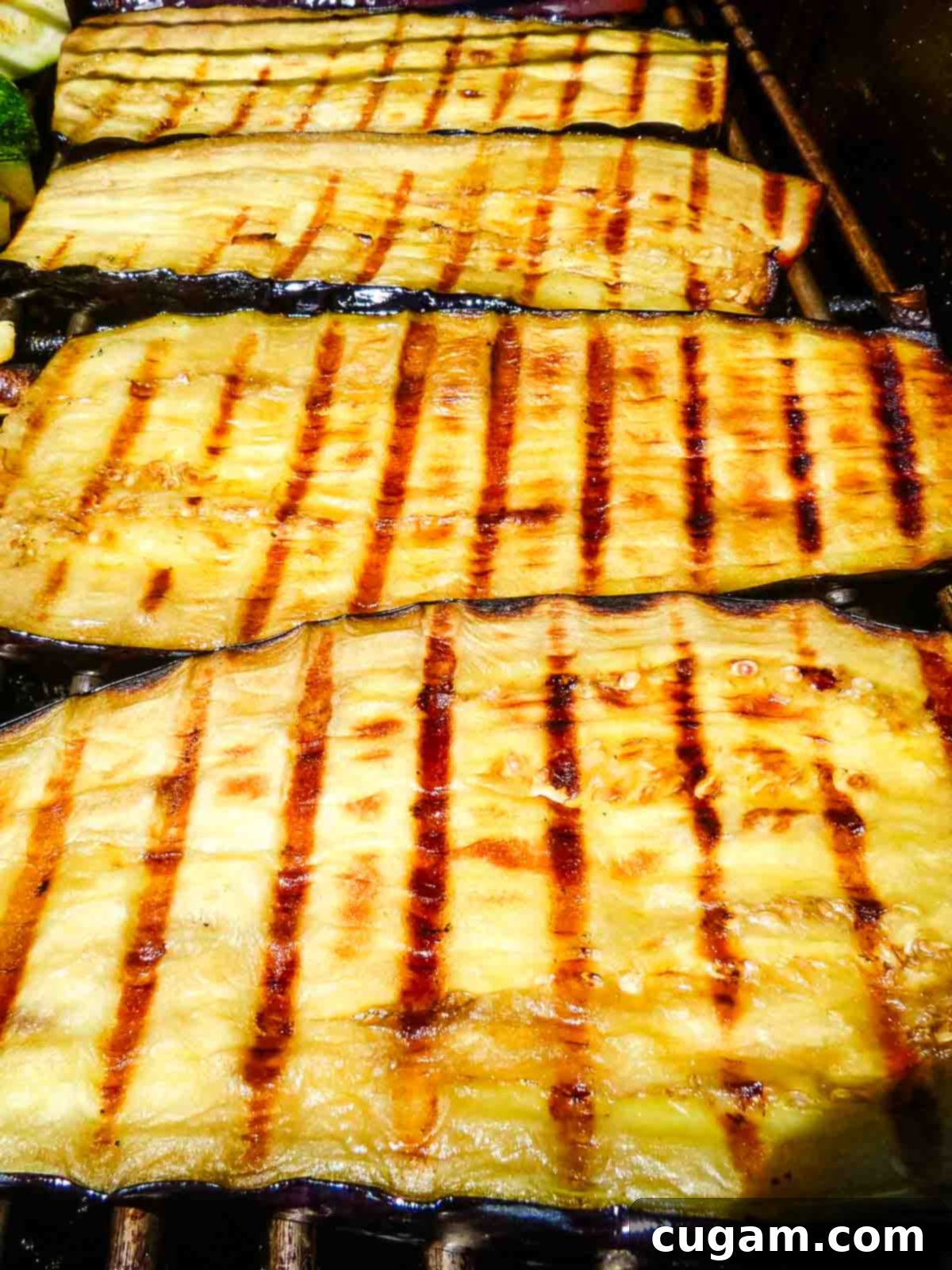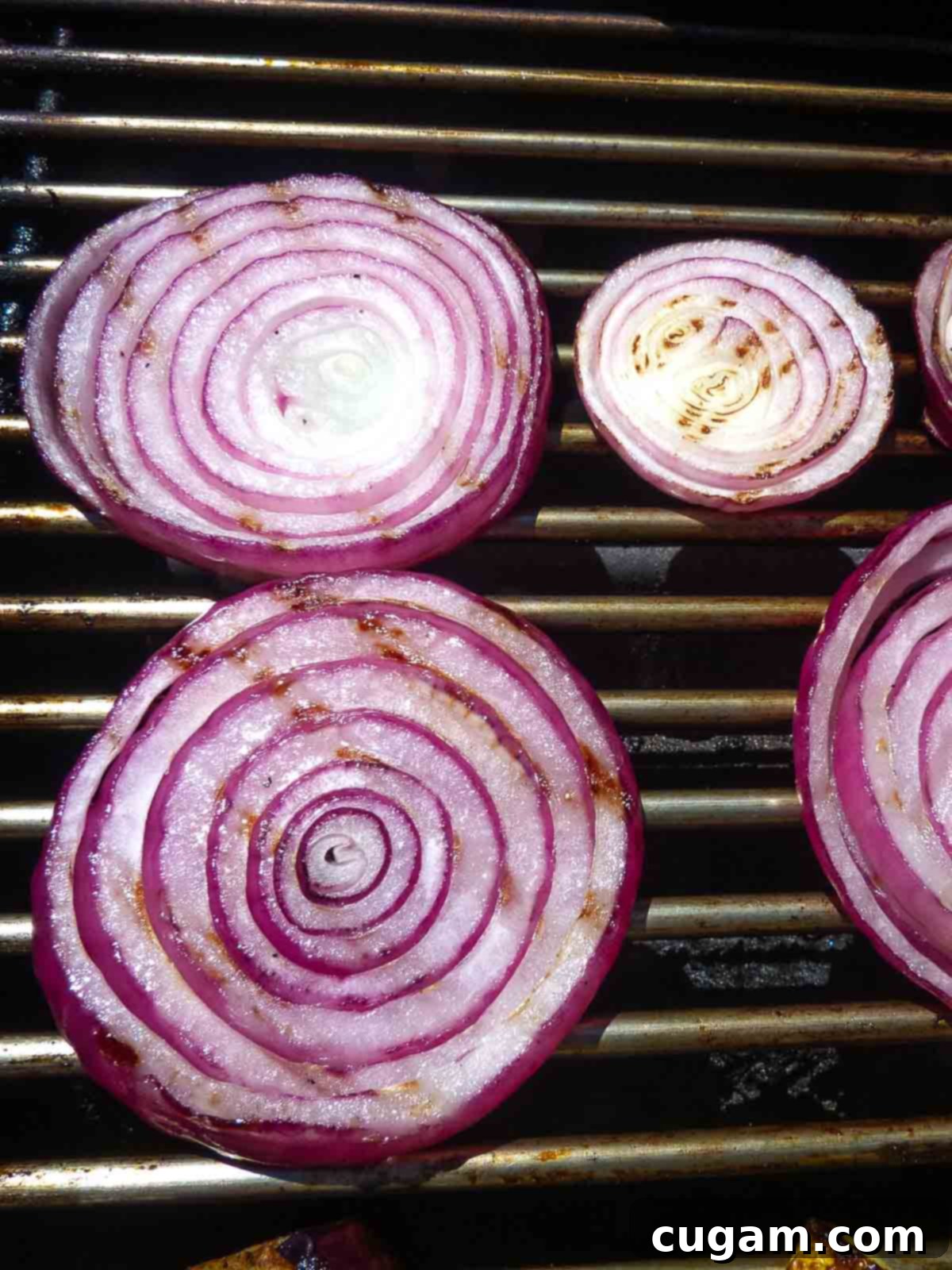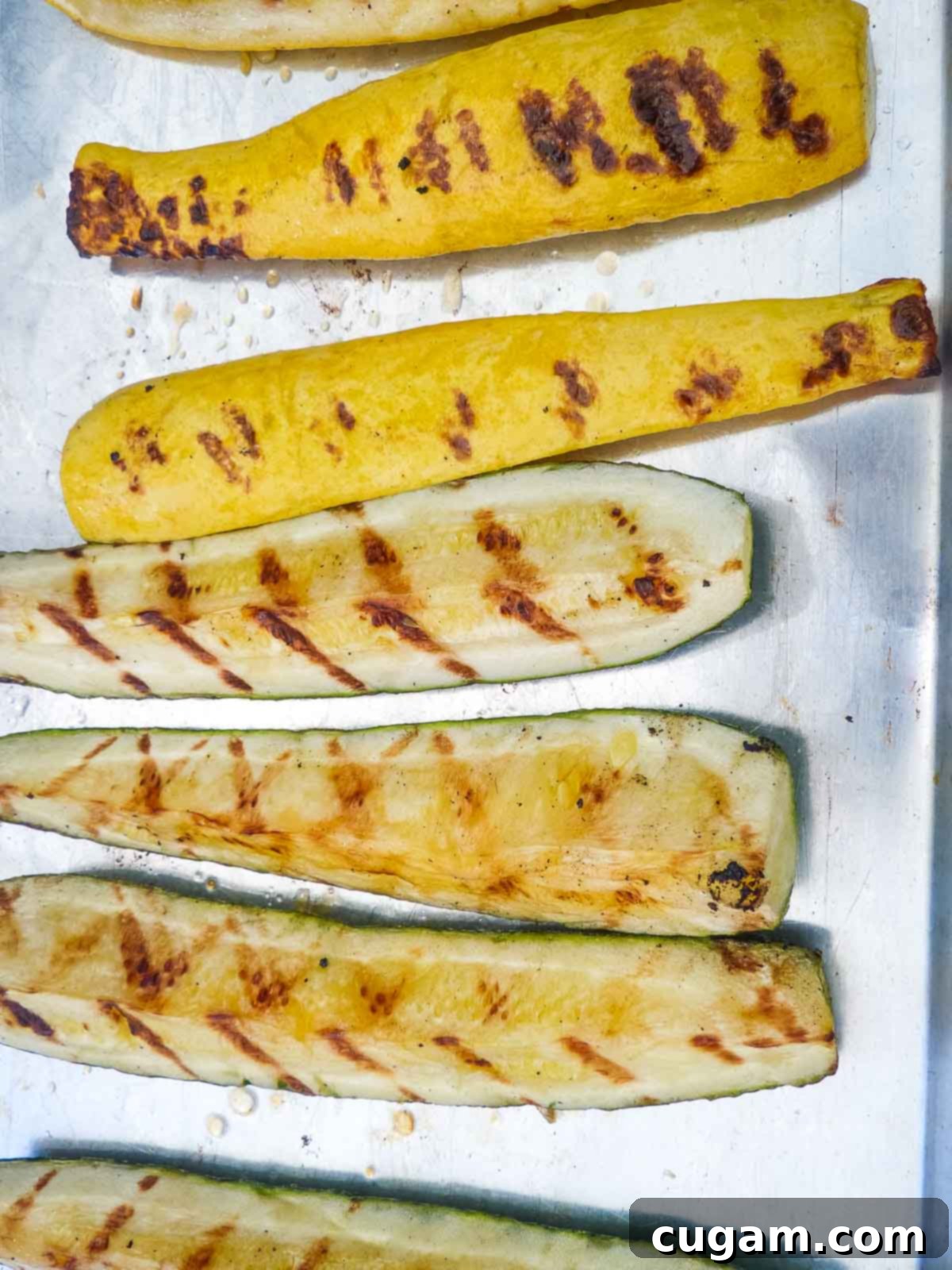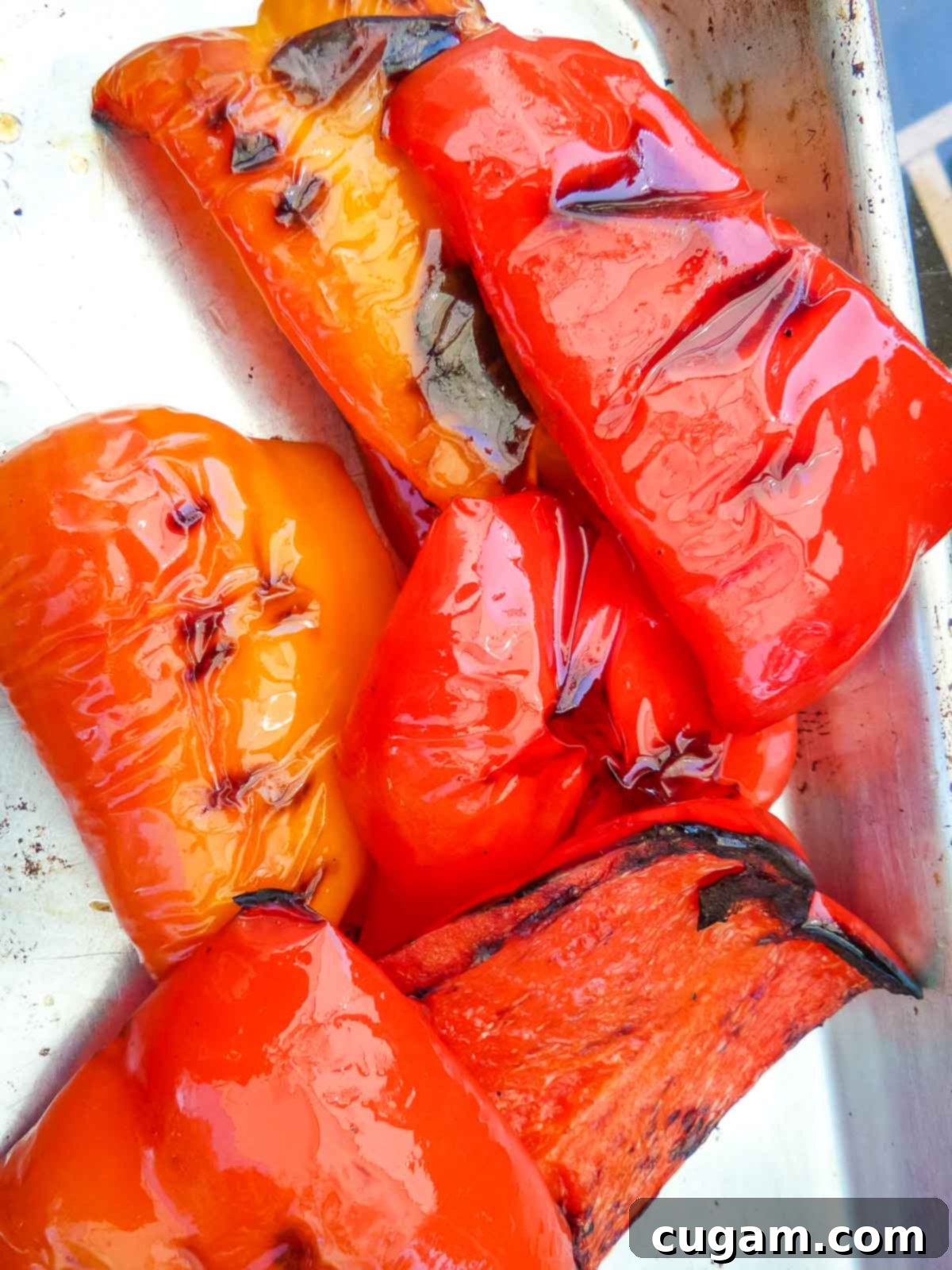Easy Grilled Ratatouille Salad Recipe: Your Ultimate Healthy Summer Side Dish
This Easy Grilled Ratatouille Salad Recipe offers a delightful and modern twist on classic ratatouille. By grilling the fresh produce, we transform a beloved French stew into a vibrant, smoky vegetable salad that perfectly encapsulates the essence of summer. It’s a versatile, flavorful, and incredibly healthy dish that you’ll want to make again and again.
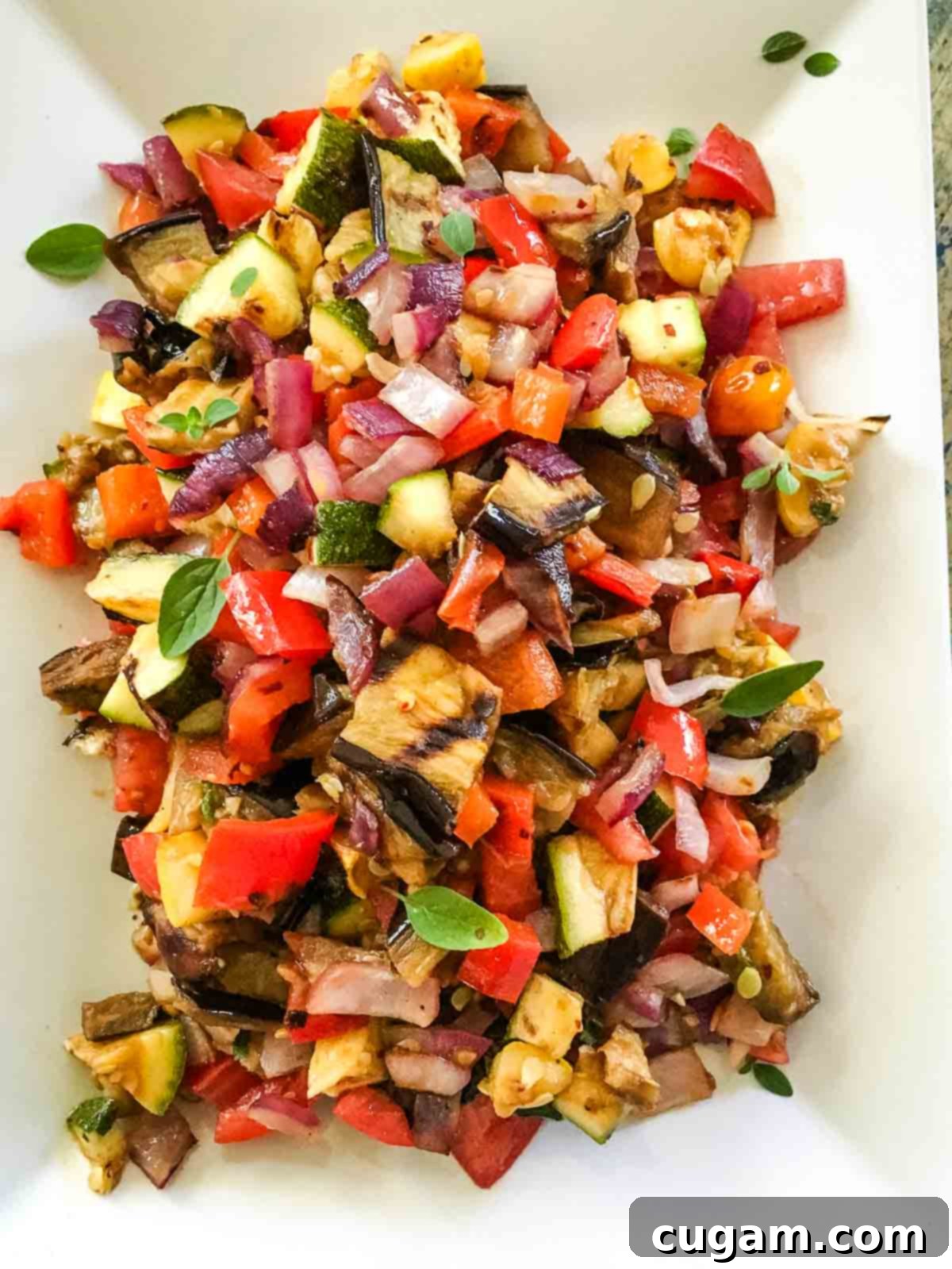
This post has been updated from the original that was posted July 27, 2016, to bring you even more tips, expanded details, and a refined recipe for the best grilled ratatouille salad!
[feast_advanced_jump_to]
When summer is in full swing and your garden is overflowing with fresh produce – or you’ve found an abundance of beautiful vegetables at your local farmers market – this Grilled Ratatouille Salad is an absolute must-make. Imagine succulent zucchini, sweet red onions, vibrant bell peppers, and tender eggplant, all kissed by the flames of the grill, then lightly tossed with a bright balsamic dressing. It’s simple to prepare, yet incredibly rich in flavor, making it an ideal side dish or light meal.
Got too much zucchini on hand? That’s not a problem; it’s an invitation to culinary creativity! Zucchini is a star in this grilled ratatouille salad, but it’s also fantastic in so many other dishes. Consider whipping up Vegan Stuffed Zucchini, a moist Zucchini Bread, fun Zucchini Pizza Bites, fluffy Zucchini Muffins, elegant Zucchini Rollatini, or even decadent Zucchini Brownies. An abundance of zucchini truly is what summer dreams are made of, providing endless opportunities for healthy and delicious meals!
Why You’ll Absolutely Love This Grilled Ratatouille Salad
This isn’t just another vegetable salad; it’s a celebration of summer flavors and healthy eating. Here’s why this grilled ratatouille salad will become your new favorite:
- Keeps Your Kitchen Cool: Say goodbye to heating up your house with the oven during scorching summer days. All the cooking happens on the grill, keeping your kitchen comfortably cool.
- Simple, Yet Flavorful: Grilling naturally enhances the vegetables’ inherent sweetness and brings out a wonderful smoky depth. A simple dressing is all it takes to highlight these fantastic flavors.
- Irresistible Grilled Vegetables: Who can resist the char and tender texture of perfectly grilled zucchini and eggplant? The grilling process adds an incredible dimension that steaming or roasting simply can’t replicate.
- The Ultimate Potluck & BBQ Side Dish: Ratatouille salad is robust enough to travel and holds up beautifully, making it the perfect guest to any backyard BBQ, picnic, or potluck. It’s always a crowd-pleaser!
- Flavor Enhances with Time: This salad tastes even better as it sits and the flavors meld, making it an excellent candidate for healthy meal prep. Prepare a big batch at the start of the week and enjoy it for days.
- Easily Customizable & Versatile: Not only is it delicious on its own, but it can also be easily transformed into a hearty ratatouille pasta salad or served in numerous other creative ways (see recipe card and tips for instructions).
- Naturally Healthy & Plant-Based: Packed with nutrient-dense vegetables, this salad is naturally vegan, gluten-free, and full of fiber, making it a fantastic choice for a healthy diet.
Essential Ingredients & Smart Substitutions
Gathering fresh, high-quality ingredients is key to a spectacular grilled ratatouille salad. Here’s what you’ll need and some handy substitutions:
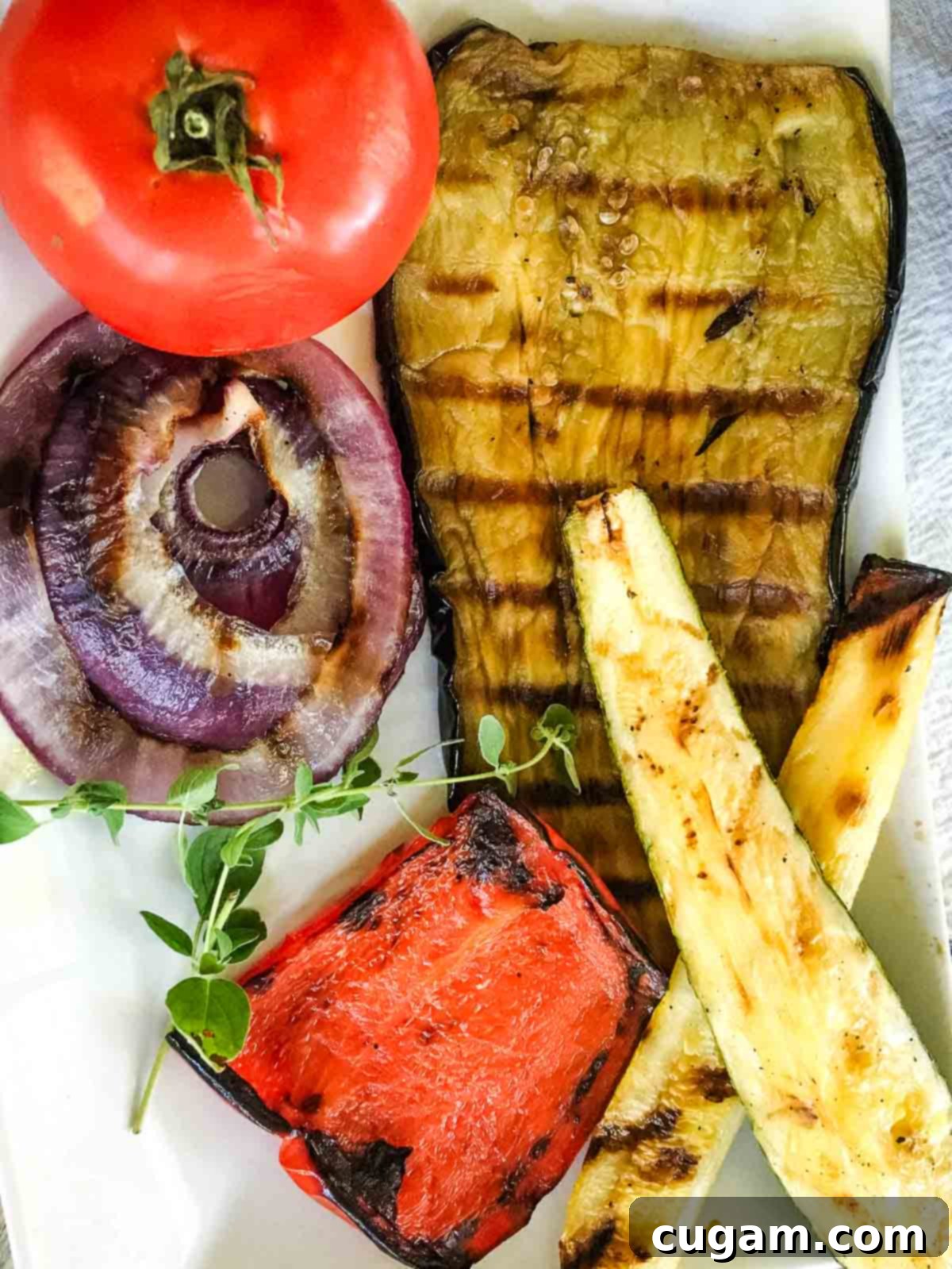
- Eggplant: This Mediterranean staple adds a wonderful meaty texture and soaks up the smoky flavors beautifully. If eggplant isn’t your favorite, you can substitute with large portobello mushrooms. Just grill them whole and slice after cooking for a similar heartiness.
- Zucchini: A quintessential summer squash, zucchini becomes tender and slightly sweet when grilled. Pattypan squash would also work excellently; simply cut them in half before grilling.
- Red Bell Pepper: Adds a pop of color, sweetness, and a slight crunch. Yellow bell peppers are a great next choice for their similar sweetness, followed by orange. Green bell peppers are more bitter, but can be used if preferred.
- Yellow Squash: Similar to zucchini in texture but often with a slightly sweeter, milder flavor. If you don’t have yellow summer squash, you can simply double up on the zucchini.
- Red Onion: Grilling red onion mellows its pungent flavor and brings out its natural sweetness, making it deliciously tender. If a large red onion isn’t available, a white onion can substitute, but ensure it’s large enough to cut into thick rounds that won’t fall through the grill grates.
- Tomato: Fresh, ripe summer tomatoes are crucial for flavor, juicy texture, and a touch of acidity that brightens the entire salad. Nothing beats a garden-fresh tomato! You can substitute with cherry tomatoes, grape tomatoes, or pear tomatoes; just cut them in half.
- Olive Oil: Essential for coating the vegetables before grilling, preventing them from sticking, and helping achieve that beautiful char. Use a good quality extra virgin olive oil for the best flavor. If you’re short on oil for basting, at least generously oil your grill grates.
- Balsamic Vinegar: Provides a tangy-sweet counterpoint to the grilled vegetables. Red wine vinegar is an excellent substitute if you don’t have balsamic, offering a similar acidic lift.
- Fresh Herbs: Fresh herbs elevate this salad from good to extraordinary. I adore sprinkling it with fresh oregano leaves, which add an earthy, aromatic touch. Fresh basil leaves are also a fantastic option, contributing a sweet, peppery note. If fresh herbs aren’t available, you can substitute with 1-2 teaspoons of dried Italian seasoning, or 1 teaspoon each of dried basil and dried oregano.
- Coarse Sea Salt & Crushed Red Pepper: These simple seasonings enhance all the other flavors. The sea salt draws out moisture and seasons from within, while crushed red pepper adds a subtle, pleasant warmth. Adjust to your spice preference!
Mastering the Art of Grilled Ratatouille Salad
Making this salad is straightforward, but a few tips will ensure perfectly grilled vegetables and maximum flavor:
Step-by-Step Grilling Guide:
- Prepare the Veggies for Grilling:
- Eggplant: Trim off a small sliver from the top and bottom, discarding the stem. Then, cut the eggplant lengthwise into ¼-inch slices. This ensures even cooking and good surface area for grilling.
- Zucchini & Yellow Squash: Cut these lengthwise in half, and then into quarters. Aim for pieces that are substantial enough to handle on the grill and won’t fall through the grates.
- Onions: Slice red onions horizontally (not through the stem) into thick rounds, about ½-inch thick. Thicker slices hold together better on the grill.
- Bell Peppers: Cut the bell peppers top to bottom on each side to create four larger, flatter pieces. Remove the seeds and white membranes.
- Preheat Your Grill:
- For a gas grill, turn it to medium-high heat. Allow it to preheat for about 10-15 minutes to reach a consistent temperature.
- If you’re using a charcoal grill, arrange your coals for direct medium-high heat, cover the grill, and let it heat up for about 15 minutes before placing vegetables on the grates. Ensure the grates are clean.
- Oil the Vegetables: Brush the cut side of all the prepared vegetables with 2 tablespoons of olive oil. Alternatively, place all the cut vegetables in a large bowl and toss them with the olive oil until they are evenly coated. This step is crucial for preventing sticking and promoting beautiful grill marks.
- Grill to Perfection:

Carefully place the oiled vegetables in a single layer on the hot grill. It’s important to leave the vegetables undisturbed. Resist the urge to move them around frequently, as this allows them to develop those coveted, deep grill marks and ensures even cooking.

After 3-4 minutes, use tongs to carefully flip the vegetables to the other side. You’ll be rewarded with gorgeous grill marks if you’ve been patient! Continue grilling for another 3-4 minutes per side, or until tender-crisp.

Remove any vegetables that are tender and cooked through from the grill as they finish. Different vegetables may cook at slightly different rates.

If you can’t fit all the sliced veggies in a single layer on the grill, that’s perfectly fine! Work in batches to avoid overcrowding the grill, which can lead to steaming instead of charring.
- Dice and Assemble the Salad: Transfer all the beautifully grilled vegetables to a large cutting board. Once cool enough to handle, dice them into similar-sized, bite-sized chunks. This creates a cohesive salad texture.
- Season and Serve: Place the diced grilled vegetables into a large mixing bowl. Dice the fresh tomatoes and add them to the bowl. Drizzle generously with balsamic vinegar, sprinkle with coarse sea salt and crushed red pepper. Add your fresh oregano leaves. Mix everything well, gently tossing to combine all the flavors. Taste for seasoning and adjust as needed – you might want a bit more salt, pepper, or vinegar to suit your preference.
Debra’s Pro Tips for the Best Grilled Ratatouille Salad
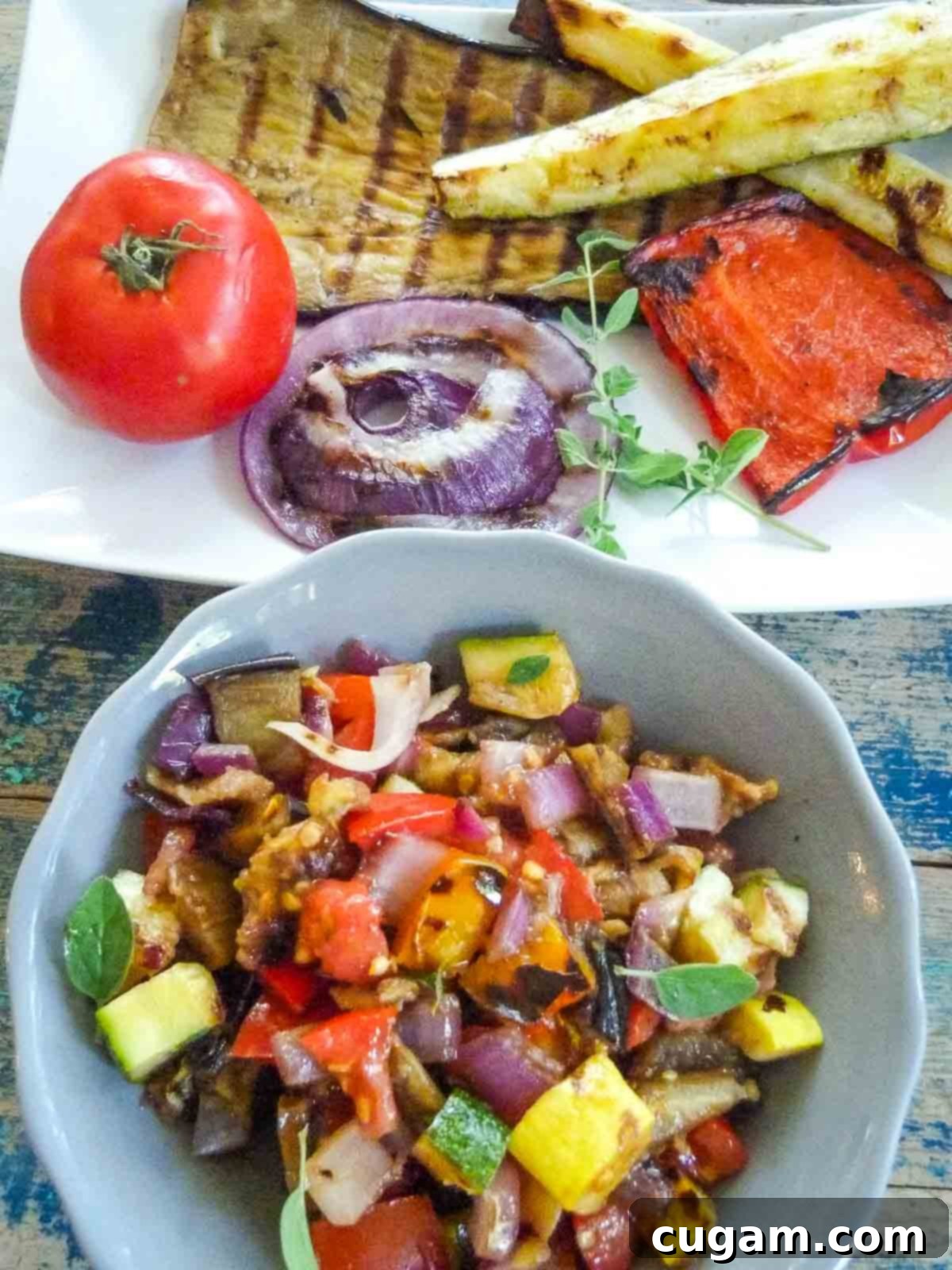
- Uniform Dicing is Key: After grilling, cut the vegetables into bite-sized pieces that are roughly similar in size. This ensures that every forkful offers a balanced mix of flavors and textures.
- Patience on the Grill: For those perfect grill marks and deep, smoky flavor, leave your veggies undisturbed on the grill until they naturally release. Don’t flip them too soon!
- Make it a Meal: This salad is hearty enough to be a light lunch or dinner. For a more substantial meal, add your favorite plant-based protein like grilled tofu, chickpeas, or white beans. Grilled halloumi cheese also makes a delicious addition if you’re not strictly vegan.
- Prepare Ahead for Enhanced Flavor: This salad is one of those magical dishes that tastes even better the next day as the flavors have more time to meld and marinate. It’s perfect for make-ahead meals or entertaining. Remember to bring it to room temperature before serving for the best experience.
- Don’t Skimp on Fresh Herbs: Fresh oregano or basil provides an incredible burst of aromatic flavor that truly completes the ratatouille experience. If you can, use them!
- Experiment with Balsamic Glaze: For an extra layer of gourmet flavor, reduce some balsamic vinegar on the stovetop until it thickens into a glaze. Drizzle this over the finished salad for a touch of sweetness and sophistication.
Storage & Serving Suggestions
Knowing how to properly store and serve your Grilled Ratatouille Salad ensures you can enjoy its deliciousness for days.
- Storage: Transfer any leftover salad to an airtight container and store it in the fridge. It will stay fresh and delicious for up to 5 days, making it an excellent option for meal prepping throughout the week.
- Serving Temperature: This salad is wonderfully versatile and can be enjoyed in multiple ways. Serve it warm straight off the grill, at room temperature (which allows the flavors to truly shine), or chilled. It’s truly delicious at any temperature!
- Freezing: The texture of grilled vegetables tends to change significantly after being frozen and defrosted, often becoming mushy. Therefore, I do not recommend freezing this salad as is. However, if you have leftovers you wish to save, you can puree the salad into a delicious ratatouille dip or sauce, then freeze that. Thaw and enjoy with crusty bread or as a pasta sauce.
- Reheating: While it’s delightful cold or at room temp, if you prefer to serve your ratatouille salad warm, gently reheat it. Spread the salad on a baking sheet and warm it in an oven preheated to 300°F (150°C) for about 10-15 minutes, or until just warmed through. Avoid overheating to maintain the vegetables’ texture.
Discover More Healthy Grill Recipes
If you love the ease and flavor of grilling, be sure to check out these other fantastic healthy recipes that make the most of your grill:
- Grilled Asparagus with Mustard Drizzle
- Grilled Potato Salad Recipe
- Grilled Peaches with Balsamic Chocolate Drizzle
- Mediterranean Grilled Vegetable Skewers
Did you know commenting and rating recipes is one of the best ways to support your favorite food bloggers? If you made this delicious Grilled Ratatouille Salad, please consider leaving a five-star rating below and a comment sharing your experience. Also, we’d love to see your creations! Please share your photos on Instagram by tagging me @dkhealthcoach and using the hashtag #debraklein. Your support means the world!
📖 Recipe
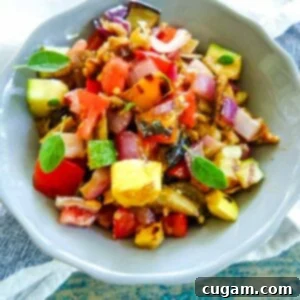
Grilled Ratatouille Salad
Rate this Recipe
Pin Recipe
Ingredients
Ingredients:
- 1 large eggplant
- 1 large zucchini
- 1 large yellow summer squash
- 1 large red onion
- 2 bell peppers
- 2 Tablespoons olive oil
- 3 tomatoes
- ¼ cup fresh oregano leaves
- ½ teaspoon coarse sea salt
- ½ teaspoon crushed red pepper
- 1-2 Tablespoons balsamic vinegar
Instructions
-
Prepare veggies for grill: slice eggplant lengthwise into ¼” slices. Slice zucchini and squash into quarters, lengthwise. Cut peppers into large chunks and thickly slice onion horizontally. Brush all veggies on both sides with olive oil.
-
Heat grill to medium high and then carefully place veggies onto grill with tongs. Do not move veggies around, be patient and allow grill marks to form.
-
Most veggies will take about 4 minutes per side to get nice grill marks, depending on thickness. Peek at the underside before flipping to the other side. Remove when veggies are tender, yet not too cooked that they will fall apart when diced.
-
While veggies are cooling, roughly chop tomatoes and place in a large bowl. Dice grilled veggies in similar size and add to bowl. Sprinkle with vinegar, salt, crushed pepper, oregano and toss gently. Taste for seasoning, adding more S+P or vinegar to suit you.
Notes
Fresh Oregano: If fresh oregano is not available, don’t worry! You can easily substitute with other fresh herbs like fresh basil, thyme, or parsley. For dried herb alternatives, use 2 teaspoons of dried Italian seasoning, or a combination of 1 teaspoon dried basil and 1 teaspoon dried oregano.
Nutrition
Note
The nutrition calculations were done using online tools. To obtain the most accurate representation of the nutritional information in any given recipe, you should calculate the nutritional information with the actual ingredients you used. You are ultimately responsible for ensuring that any nutritional information is accurate, complete and useful.
